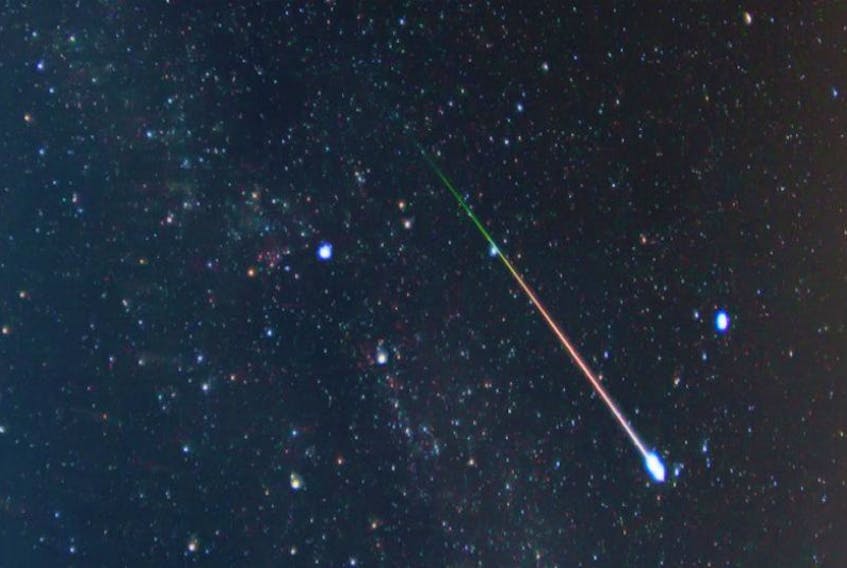Mercury is lost from view until the first week of August, as it is now passing between Earth and the sun, a celestial phenomenon known as inferior conjunction.

Only the two planets closer to the sun than Earth – Mercury and Venus – can have inferior conjunctions (their orbits carrying them between Earth and the sun), and superior conjunctions (when they pass behind the sun), as viewed from Earth.
When a planet is in conjunction with the sun, either inferior or superior, it does not necessarily pass directly in front of or behind the sun. Depending on the particular alignment of the planets in question within the solar system, their line of sight, relative to the sun, as viewed from Earth, may result in the planet merely becoming lost in the glare of the sun, as seen from Earth. Incidentally, if you were standing on the surface of Mars, you could, if the Martian sky was clear, witness Earth experience both inferior and superior conjunctions with the sun. The outer planets – Mars, Jupiter, Uranus, Neptune and Pluto – only experience superior conjunctions with the sun, as viewed from Earth.
Likewise, Mars is also now lost from sight as it moves towards its superior conjunction with the sun in early September, before reappearing in the night sky in early October. We have also lost sight of our “morning star” – Venus – as it has disappeared into the glow of the rising sun, heading for its mid-August superior conjunction.
Events:
July 25 - Last Quarter Moon
Aug. 1 - New Moon
Aug. 2 - Moon at perigee (closest to Earth)
Only the majestic planets – Jupiter and Saturn – remain to highlight our night sky through the remainder of July and into early August. A bit dimmer at mag. – 2.4 than at the beginning of the month (mag. –2.6), Jupiter still shines brilliantly all night long to the upper left of the bright red star Antares in the constellation of Scorpius – the Scorpion in the SSE sky in late July and early August. On any clear night, look for Jupiter’s four largest moons – Io, Europe, Callisto and Ganymede – as they change positions – some on an hourly basis – around their celestial sire.
Jupiter’s celestial cohort, Saturn, joins his royal sibling in the night sky for the next several weeks. Look for the “teapot” asterism (yes, it does actually look like a teapot when you connect the dots) in the constellation of Sagittarius – the Sea Goat just above the southeast horizon about an hour after sunset. Saturn, a warm, yellowish object, sits to the left of the teapot’s handle.
Unfortunately, because it is low to the horizon, it will be difficult to get clear and steady views of this magnificent planet and its famous ring system. You will be looking through more of the Earth’s atmosphere, which, due to its varying levels of density, causes objects lower to the horizon to shimmer and waiver more than objects being observed higher (towards the zenith, or the point directly overhead) in the night sky. Still, it is always worth a quick look at this planet with binoculars or a scope; just don't expect astronomy magazine-quality views.
Perseid meteor shower
As mentioned in my last article, the Perseid meteor shower will peak in mid-August. Unfortunately, this year the near Full Moon will be in the sky on the night/morning of the shower’s peak. However, you can still catch sight of some early Perseids as they strike the Earth’s upper atmosphere over the course of the next several weeks. The Perseid meteor stream (think wide and very long conveyor belt) orbits around the sun and back out into space.
Every year, around mid-summer, Earth, in its yearly orbit around the sun, regularly intercepts that stream of comet debris, and the sky is filled with bright Perseid meteors. Earth begins to intercept the outer edges of the Perseid stream around mid-July (thus the Perseids you might catch sight of on any clear night during the coming weeks), plows through its densest part in mid-August (thus the “peak”), and finally leaves the opposite outer edge of the stream somewhere around Aug. 24. When outside on any clear night in the coming weeks, keep glancing skyward; you might be pleasantly surprised by what you see.
Until next time, clear skies
Glenn K. Roberts lives in Stratford, P.E.I., and has been an avid amateur astronomer since he was a small child. His column, Atlantic Skies, appears every two weeks. He welcomes comments from readers at [email protected].
More ATLANTIC SKIES:









